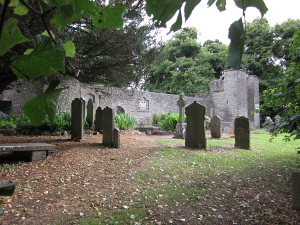Burial of Andrew Hall in Mainham in 1899
Published in Le Chéile November 2012
In February 1899 due to a mix-up the wrong corpse was buried in Mainham graveyard. The circumstances of this unfortunate incidence were due to a human error but was soon rectified by the authorities responsible for the administration of the local Union.
The union system at the time had responsibility of caring for unfortunate members of the community of poor means who were accommodated in the Union Workhouses. They were usually the destitute poor who did not have financial means of support. The Unions were governed by an elected committee known as the Board of Guardians. They were usually referred to as Poor Law Guardians or PLG members.
Mainham cemetery today consist of three sections. The burial ground in use in 1899 was the section known as the original graveyard which is the area that surrounds the ancient church and is enclosed by a circular wall.
According to Denis Byrne, the wardmaster at the Workhouse Hospital in Naas, an inmate died in late February 1899 and his brother arrived with a PLG member to collect the remains. They brought a coffin with them and the dead body was placed in the coffin by the warden of the hospital. It appears that neither the brother of the deceased nor the PLG member entered the morgue to identify the body. They subsequently left for Mainham graveyard where the burial was to take place. Shortly after, however, the warden discovered that the wrong body had been placed in the coffin and immediately set out for Mainham. He arrived before the burial took place but the PLG member that accompanied the funeral to Mainham suggested that it didn’t matter about the mistake, indicating that the burial should go ahead, which it did.
When the matter was brought to the attention of the Union authorities they rightly decided that the deceased individual who had burial rights in Mainham should be interred in his family burial plot. An order was then obtained from the coroner Dr Smyth and the corpse that had been buried in error was exhumed and buried in a different section of Mainham graveyard. The corpse of the man that had been left behind in the morgue of Naas Workhouse Hospital was then buried in his family burial plot in Mainham.
The matter was discussed subsequently at a meeting of Naas Board of Guardians in the Workhouse in Naas. Attending the meeting were the Chairman, Baron de Robeck, Thomas Cooke Trench of Millicent and R West Manders of Castlesize and other Guardian members including the one that gave the go-ahead for the burial despite been informed of the error. It was stated at the meeting that one of the rules made by the Board was that the name of a deceased person should be pinned to the shroud of the corpse and also that the names were to be written on the coffin. The chairman indicated that the orders of the Board were not complied with on this occasion.
The name of the deceased that was exhumed and reburied in Mainham was Andrew Hall and his place of origin is unknown.1 Inmates that died in Naas Workhouse were usually interred in the Workhouse Cemetery which is still in existence and situated close to the present car park of Naas General Hospital. It is likely that Andrew Hall would have been buried in this burial ground if the mishap had not occurred.
It is a positive development that now in the second decade of the twenty-first century the 'Old section of Mainham graveyard and the Workhouse cemetery in Naas known as the Famine graveyard are well cared for despite both having been closed for internments in nearly a century.

